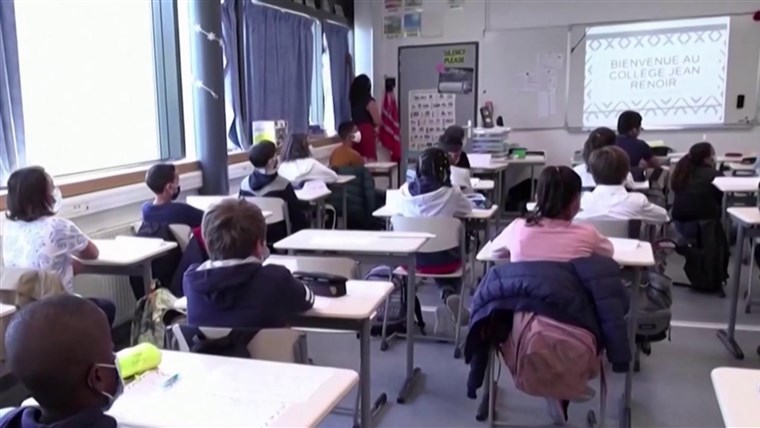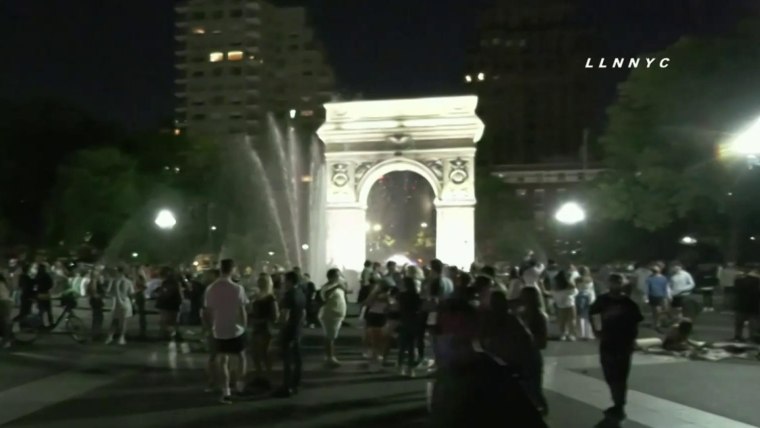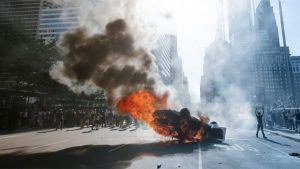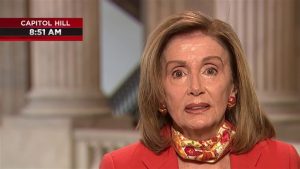The back-to-school preparations at the Sharyland Independent School District in southern Texas this year include a variety of supplies now common in daily life amid the pandemic: plastic dividers, masks and hand sanitizer.
They also include something not as common: body temperature screening terminals.
The district, which serves about 10,200 students across 13 campuses, spent more than $178,000 on 52 walk-through infrared temperature scanners from SafeCheck USA, a Miami-based company that launched about six months ago. The school district made the purchase without testing the technology after watching a demonstration over Zoom, Assistant Superintendent Ismael Gonzalez said.
“We are looking forward to reopening our schools. We miss our students,” he said, noting that the school district had been “flooded” with pitches for new Covid-19 mitigation tools.
Body temperature checks have emerged in recent months as one of the more advanced and passive coronavirus mitigation techniques, with tripods mounting infrared cameras now a common sight in the entrances of buildings.
But just how well temperature checks work remains unclear, and epidemiologists caution that mass temperature screening systems do little to detect people infected with the coronavirus, and potentially make people less safe by giving the false impression that Covid-19 is not present.
“In the context of schools, fever screening is a particularly bad idea,” said Katelyn Gostic, an epidemiologist at the University of Chicago, who studies the use of symptom screening systems for catching infectious diseases.
“Fever screening only works if you have a fever. And we know that a lot of infections in children and young people seem to be asymptomatic or mild enough that you might not have a fever for several days, even though you’re contagious, or you might never develop a fever at all,” Gostic said.
That has not stopped companies, many newly formed or with little track record in temperature detection technology, to join in the rush to pitch lucrative contracts to schools, offering fever checks, contact tracing and other safety services. A handful of companies have pivoted from selling gun detection systems to now selling temperature screening systems in an effort to meet demand and prevent the spread of the coronavirus on school campuses.
Sept. 8, 202003:42
Many of the systems being marketed to schools now are not vetted by the Food and Drug Administration — the agency relaxed its rules in April to allow broader use of devices for temperature screening — nor independently tested as accurate at detecting fevers, let alone symptoms that arise from Covid-19. Yet, school districts across the country are spending hundreds of thousands of dollars, often using funds from the Coronavirus Aid, Relief and Economic Security Act, or the CARES Act, on these systems in the hope that they will help mitigate the spread of the outbreak.
SafeCheck USA’s co-founder William Kakon did not respond to questions about the experts’ concerns over the technology’s accuracy. He said that the system had been tested by third parties but declined to provide details.
Other school districts have also spent considerable amounts of money on similar systems.
In the Dothan City School District in Alabama, administrators opted to buy 23 fever screening systems for a total of $400,000, being set up at the entrances of the district’s 17 campuses serving around 8,000 students. The purchase was made prior to testing the systems, according to Dennis Coe, the district’s chief operations officer and acting superintendent.
Download the NBC News app for breaking news and politics
The school board of Fayette County in Georgia reportedly approved the purchase of up to 75 temperature check cameras made by Hikvision — a Chinese company the Trump administration placed on a trade blacklist in October for its role in the surveillance of China’s Muslim minority — for a cost of up to $525,000. Elsewhere in Alabama, the Baldwin County School District spent nearly $1 million to buy 144 Hikvision cameras, a local NBC affiliate reported.
The appeal, according to Shawn Van Scoy, the superintendent of the Gananda Central School District in New York, is preventing congestion at the start of the day. The Gananda district also purchased a set of Hikvision cameras for screening fevers.
“Everything is cumbersome when we are trying to get a thousand kids in school in the morning,” Van Scoy said. “This will allow us to assess 40 students every minute as they enter the doors of our building.”
The SafeCheck USA devices bought by the Sharyland schools have two infrared sensors that the company said can read the temperatures of up to 70 people per minute. Kakon said in an interview that the company sold its devices to almost 100 schools in the United States.
Whether it’s infrared walk-through sensors or thermal cameras, the technology does the same thing, according to David Pascoe, professor emeritus at the University of Auburn, who served as director of the Thermal and Infrared Imaging Lab and as a U.S. delegate of the International Organization for Standardization for pandemic screening.
“They’re all the same. You’re looking at the infrared spectrum of temperature that’s being radiated from the body,” Pascoe said, adding that it is possible to get a good temperature reading of someone using these systems, but the way the reading is done has to be in line with international standards for using such devices for it to be effective. This means scanning one person at a time after they’ve had enough time to regulate their temperature from outside and getting a good reading of each person’s face, preferably while practicing physical distancing, so a tall person doesn’t block the face of a shorter person.
Scanning large numbers of people every minute, he said, is less likely to produce accurate temperature readings.
“This is no different than having a fake camera in the building and people have the illusion that they’re safe and they let their guard down,” he said.
Other schools have bought Feevr thermal cameras from Los Angeles-based technology startup X.Labs, which until March specialized in selling thermal cameras for detecting concealed weapons. The Kershaw County School District in South Carolina bought 20 Feevr cameras for about $75,000 in an effort to check its 10,000 students for Covid-19 symptoms, while the Van Vleck Independent School District in Texas bought three cameras for about $10,000.
Sept. 7, 202001:38
Feevr uses the Flir One thermal camera, which attaches to a smartphone. Flir Systems promotes this model, which costs from $299, to electricians and mechanics for identifying hot spots in machinery. According to Flir, the camera is not sensitive enough for accurately checking human skin temperature.
X.Labs said it developed its own software to improve the performance of Flir’s entry-level cameras.
X.Labs said that students entering a building must wait 90-120 seconds before Feevr can accurately estimate body temperature — and longer if they’ve been in direct sunlight or exercising.
When asked if Feevr devices detected fevers, as indicated by the product’s name and early marketing materials, X.Labs co-founder Todd Dunphy responded: “No.”
“It’s a screening mechanism to determine whether or not a person has elevated skin temperature and skin temperature is actually not related to febrile conditions,” Sam Skinner, chief experience officer at X.Labs, added.
Dunphy said that X.Labs developed Feevr at the request of customers who already used its gun detection technology, but acknowledged that half the people with Covid-19 are asymptomatic and that he didn’t think Feevr would be a “big part of our business going forward” even though “hundreds” of clients have bought into the system.
Some of the more established vendors of security products to schools, including Axis Communications, have avoided the fever detection business altogether over concerns that thermal cameras aren’t accurate enough to detect fevers quickly in large groups because of how sunshine, exertion and masks can alter readings.
“If you have 500 students entering between 8:00 a.m. and 8:15 a.m., we don’t believe we are going to make a product work accurately enough,” said Fredrik Nilsson, vice president of the Americas at Axis Communications, a major supplier of surveillance cameras to schools, retailers and other businesses. “We are very long term and not opportunistic.”
“If you have 500 students entering between 8:00 a.m. and 8:15 a.m., we don’t believe we are going to make a product work accurately enough.”
He compared the proliferation of companies selling fever detection tools to those that sold facial recognition technology in the aftermath of the terror attacks of Sept. 11, 2001.
“A lot of airports went out and spent hundreds of thousands of dollars to install facial recognition at check-in and realized it wasn’t accurate enough and they had tens of thousands of false positives a day,” he said, warning that schools could find themselves in a similar predicament.
Nilsson said there are other “tried and tested technologies that can be repurposed to have safe reopenings — for example using video analytics to count the number of people going in and out of a space to make sure it’s not over capacity or to create heat maps of congested areas to inform social distancing rules.
In North Carolina, Phoenix Academy charter schools spent $10,000 on its set of three Feevr systems, which is only a fraction of the total $250,000 the small 3-school system is spending to deal with Covid-19, according to Brandon Lenoir, a spokesman for Phoenix Academy.
“None of this is cheap. We spent a lot of money, but how do we put a price on the safety of our kids?” Lenoir said.




















